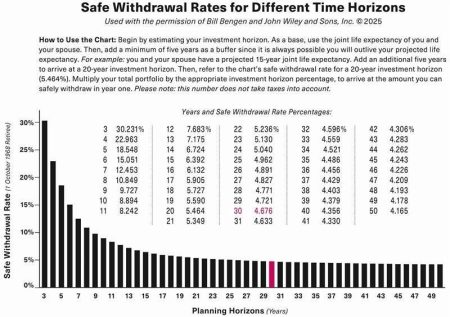Required minimum distributions from IRAs and 401(k)s can become a major tax burden during retirement, but you can reduce the burden.
The percentage of the IRA that must be distributed as an RMD rises each year. That often means greater distributions and higher adjusted gross income, which can increase both taxable income and the Stealth Taxes imposed on many retirees.
Shrewd retirees can turn the tables and change RMDs from burdens into opportunities.
Consider these strategies to optimize your RMDs. (These strategies are for traditional IRAs and their original owners, not for Roth IRAs or inherited IRAs.)
Determine the best time for the first RMD. The beginning age for RMDs changed several times in recent years from 72 for those born before 1951, 73 for those born from 1951 through 1959, and 75 for those born in 1960 or later.
The current rule is the first RMD must be taken by April 1 of the year following the year you turn age 73. If you turned 73 in June 2025, you have until April 1, 2026, to take that first RMD.
It is your 2025 RMD, even if you don’t take it until early 2026.
Most taxpayers should take the first RMD in the year they turn 73, which is 2025 in this example. If the first RMD is delayed, in 2026 you’ll take that 2025 RMD plus the 2026 RMD. Taking two RMDs in one year could increase income taxes and Stealth Taxes.
To calculate the 2025 RMD, use the IRA balance on December 31, 2024, whether you take the RMD in 2025 or 2026.
Know the aggregation rules for multiple IRAs. Someone who owns more than one traditional IRA must first separately compute the RMD for each IRA. Then, the aggregation rules give choices.
The IRAs can be treated separately, taking from each IRA a distribution at least equal to its RMD.
Or all the RMDs can be added to determine the aggregate RMD, which can be withdrawn from the IRAs in any ratio. All the RMD can be taken from one IRA. Roughly equal amounts can be taken from each IRA. Unequal amounts can be taken from each IRA.
The key is that by December 31 the total of the distributions from the traditional IRAs must at least equal the aggregate RMD.
You can use the RMDs to rebalance your portfolio, draw down and eventually eliminate the smallest IRA, or meet other goals.
Know when to aggregate and when not to. Be sure to include all traditional IRAs when calculating the aggregate RMD. For this purpose, IRAs include SEPs and SIMPLE IRAs.
Balances of inherited IRAs and any employer plans, such as 401(k)s, are not included when computing the aggregate RMD. Their RMDs must be separately computed and taken from each account.
Make charitable gifts with RMDs. Your RMD can be taken as a qualified charitable distribution, which would reduce taxable income. The QCD usually is the best way for those older than age 70½ to make charitable gifts. I discussed QCDs in detail in the past, so I won’t review them again here.
Consolidate or split IRAs. The tax law allows you to combine or split IRAs without tax consequences. It’s best to make any changes with direct trustee-to-trustee rollovers instead of transferring the money yourself.
Some people want multiple IRAs. They want each beneficiary to have a separate IRA, or the IRAs have different assets or strategies.
Or you might want to keep money that was rolled over from a 401(k) separate from other IRA assets. (That used to be required by the tax code but no longer is.)
An IRA owner might buy a qualified longevity annuity contract in an IRA, allowing RMDs on that portion of the IRA to be delayed to as late as age 85. Managing that might be easier when the QLAC is in a separate IRA.
Other IRA owners prefer to consolidate IRAs. They believe multiple IRAs are more difficult to manage. They’re also concerned the investment returns and distributions from separate IRAs might be different, so if each IRA has a different beneficiary the beneficiaries might not inherit the same amount.
Distribute assets instead of cash. There’s no need to sell assets to make the RMD in cash. RMDs can be made in property, known as an in-kind distribution. That keeps your asset allocation unchanged.
For most IRAs, an in-kind distribution involves simply directing the custodian to transfer a certain number of shares of a fund or stock from the IRA to a taxable account. The value of the shares on the day of the distribution is the amount of the distribution.
That value is the asset’s new tax basis in the taxable account. In a future sale of the asset, you’ll have a capital gain or loss based on the appreciation or depreciation after that day.
An in-kind distribution can be especially profitable when an asset declined in price and you believe the decline is temporary. Distribute the depressed asset, and the value on that day will be taxed as ordinary income to you. When the price recovers, the appreciation will be a tax-advantaged long-term capital gain when you hold the asset for more than one year after the distribution.
An in-kind distribution also is helpful when the IRA owns unconventional assets, such as real estate, mortgages, or a small business. It’s hard to sell portions of such assets to make an RMD in cash. Instead, make an in-kind RMD by creating paperwork that transfers a percentage of the asset’s ownership to your name.
Decide the best time of year to take RMDs. You can take the RMD at any time during the year. Some people schedule equal monthly distributions, because they like the regular cash flow. Others take distributions early in the year to be sure the RMD requirement is met.
Still others wait until the near end of the year. They want to maximize the IRA’s tax-deferral of gains and income and delay paying estimated taxes on distributions.
Take more than the RMD. The RMD is the minimum that must be distributed each year. You can distribute more.
You might want to take a larger distribution when your income tax rate for the year will be lower than usual because of either higher deductions or lower income. That will reduce the RMD next year, when your tax rate might be higher.
You also might want to distribute more than required in order to reduce future RMDs and the taxes that come along with them.
Read the full article here









